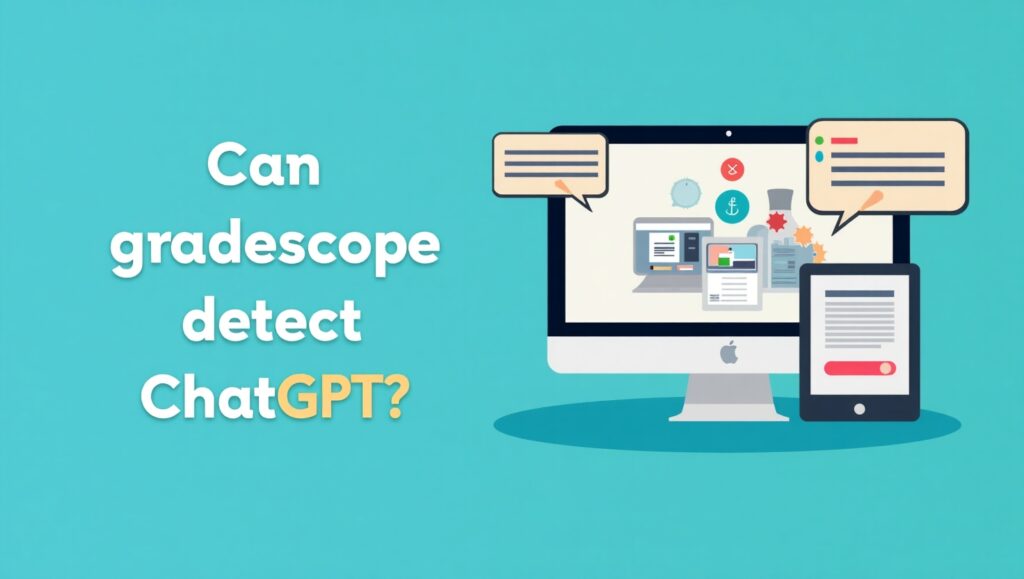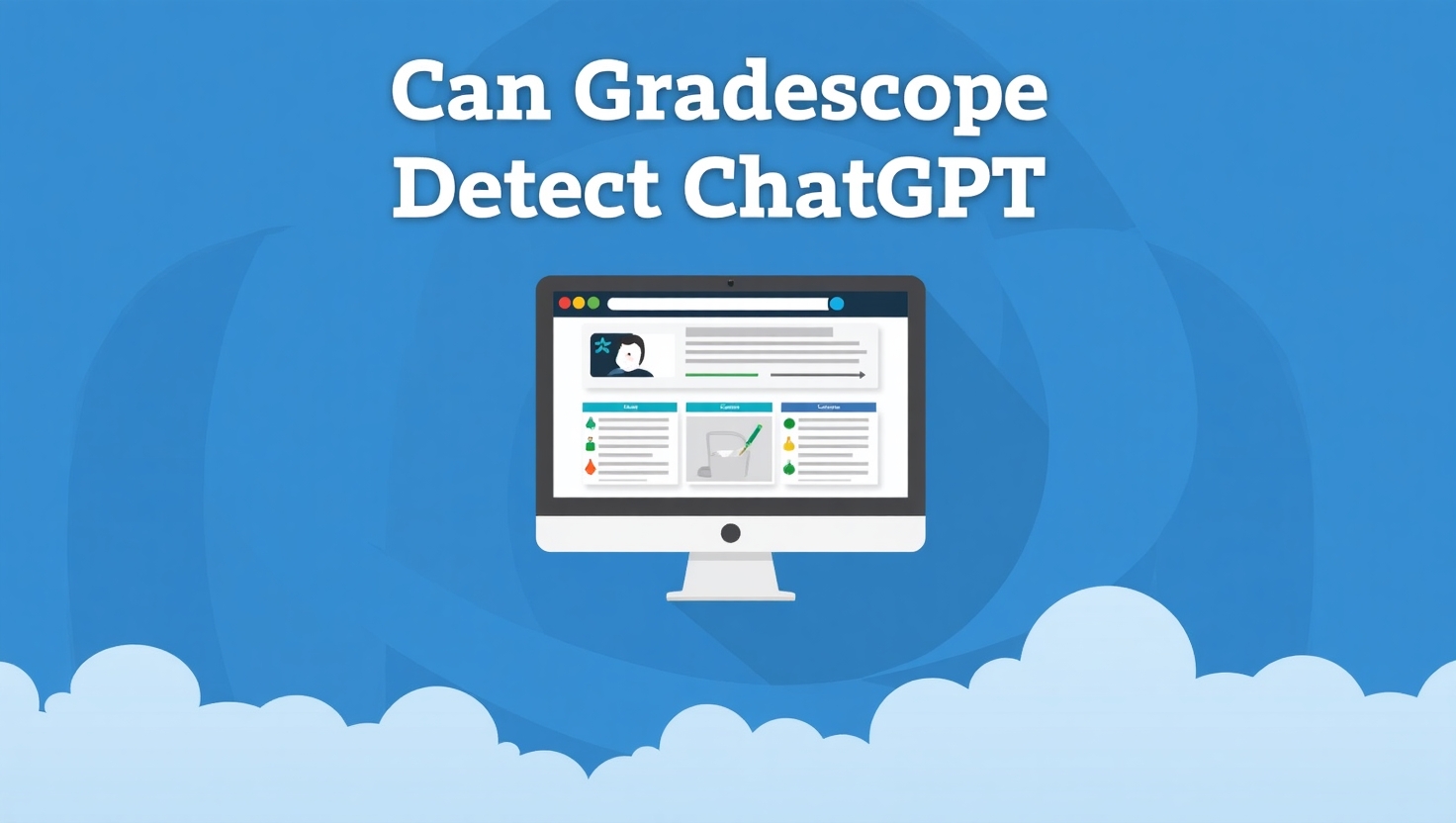Gradescope is a widely used online platform that helps educators manage assignments, grade student work, and uphold academic integrity. Meanwhile, ChatGPT, an AI language model developed by OpenAI, can generate human-like text, raising concerns about its potential misuse in academic settings. As AI tools become more prevalent, a pressing question emerges: Can Gradescope detect ChatGPT?
What is Gradescope?
Gradescope is an online assessment platform designed to streamline grading for instructors. Its key features include:
- Automating grading for assignments, quizzes, and exams.
- Providing detailed feedback to students.
- Supporting various assignment types, such as written submissions and programming tasks.
Gradescope also offers tools to promote academic integrity, including time limits, question randomization, and plagiarism detection. However, its primary focus is on efficient grading rather than detecting specific external tools like ChatGPT. Learn more at the Gradescope Official Website.
What is ChatGPT?
ChatGPT is an advanced AI language model created by OpenAI. It can:
- Write essays and answer questions.
- Solve problems and generate code.
- Produce human-like text based on prompts.
While ChatGPT is a valuable learning tool, its ability to create high-quality content has sparked concerns about academic dishonesty. Students might use it to complete assignments without fully understanding the material, prompting educators to seek ways to detect such misuse. Visit the ChatGPT Official Website for more details.
Can Gradescope Detect ChatGPT?

As of June 2025, Gradescope does not appear to have specific features designed to detect ChatGPT or other AI language models. Here’s a breakdown of its capabilities:
- Grading Focus: Gradescope prioritizes automating the grading process, not monitoring external tools like ChatGPT.
- Plagiarism Detection: Gradescope includes similarity detection for written assignments and a “Code Similarity” tool for programming tasks. These can identify copied content or similar submissions but are not tailored to detect AI-generated text, which is typically original.
- No AI-Specific Detection: Official Gradescope documentation, such as guides on cheating prevention, does not mention ChatGPT or AI detection. Some sources, like a WikiHow article, suggest Gradescope is used for AI detection, but this likely refers to its integration with other tools or instructor practices.
- Institutional Practices: Educators may combine Gradescope with third-party AI detection tools like Turnitin or OriginalityAI to check for AI-generated content.
While Gradescope’s plagiarism tools might flag highly similar AI-generated submissions, they are not designed to identify ChatGPT’s unique text patterns. Instructors suspecting AI use may rely on external software or manual review.
How Gradescope Prevents Cheating
Gradescope offers several features to reduce cheating opportunities, making it harder for students to misuse tools like ChatGPT:
- Time Limits: Instructors can set strict time limits for assessments, limiting the time available to consult external resources.
- Hidden Questions: Questions and responses can be hidden after the due date or time limit expires, preventing students from sharing content.
- Question Randomization: Online assignments can randomize questions or answer options, reducing the chance of collaboration or pre-written answers.
- Proctoring Integration: Gradescope supports third-party proctoring services like ProctorU, which monitor students during exams via webcams and microphones.
- Code Similarity Tool: For programming assignments, Gradescope’s “Code Similarity” tool compares student submissions to identify potential plagiarism or collusion. It supports languages like Python, Java, and C++ but does not detect AI-generated code specifically.
These features, detailed in Gradescope’s Cheating Prevention Guide, focus on proactive prevention rather than post-submission AI detection.
| Feature | Description | Purpose |
|---|---|---|
| Time Limits | Restricts assessment duration | Reduces time for external tool use |
| Hidden Questions | Conceals questions after due date | Prevents sharing of content |
| Question Randomization | Shuffles questions or answers | Minimizes collaboration |
| Proctoring Integration | Uses services like ProctorU | Monitors students during exams |
| Code Similarity | Compares programming submissions | Detects code plagiarism |
AI Detection Tools and Their Role
While Gradescope lacks AI-specific detection, educators often use separate tools to identify ChatGPT-generated content. Common tools include:
- Turnitin: A plagiarism detection platform with AI detection capabilities. Learn more about Turnitin’s AI Features.
- OriginalityAI: Designed to detect AI-written text, including ChatGPT output.
- GPTZero: Analyzes text for AI generation patterns.
These tools are not integrated into Gradescope but can be used alongside it. However, AI detection tools have limitations:
- False Positives: They may incorrectly flag human-written work as AI-generated.
- Evolving AI: As AI models improve, detection tools may struggle to keep up.
Instructors using Gradescope might submit assignments to these tools separately or rely on manual review if they suspect AI use.
Tips for Using ChatGPT Responsibly
Students can use ChatGPT as a learning tool without risking academic penalties by following these guidelines:
- Learn, Don’t Copy: Use ChatGPT to understand concepts, generate outlines, or brainstorm ideas, but write your own work.
- Avoid Direct Submission: Submitting AI-generated text as your own is considered cheating by most institutions.
- Cite AI Use: If allowed, cite ChatGPT as a source, similar to how you’d cite a book or website.
- Prioritize Originality: Focus on producing work that reflects your understanding and effort.
Using ChatGPT ethically ensures you benefit from its capabilities while maintaining academic integrity.
Consequences of Using ChatGPT for Cheating
Misusing ChatGPT in academic settings can lead to serious repercussions:
- Academic Penalties: Many schools view AI-assisted cheating as academic dishonesty, resulting in failing grades, suspension, or expulsion.
- Learning Loss: Relying on AI undermines your ability to develop critical thinking and problem-solving skills.
- Reputation Impact: Being caught cheating can damage your academic and professional standing.
Institutions often have clear policies on AI use, so students should review them to avoid unintentional violations.
People Also Ask: Related Questions
Based on common searches and discussions, here are answers to related questions:
- Can other platforms detect ChatGPT? Tools like Turnitin and OriginalityAI are designed to detect AI-generated text, unlike Gradescope.
- How accurate are AI detection tools? They are generally reliable but can produce false positives, requiring manual review.
- What are the consequences of AI cheating? Penalties vary but may include failing assignments or facing disciplinary action.
- How can instructors prevent AI-assisted cheating? Beyond Gradescope’s features, educators can use AI detection tools, design unique assignments, or emphasize in-class assessments.
Final Thoughts
AI tools like ChatGPT offer exciting opportunities for learning but also challenge traditional notions of academic integrity. Students should embrace these tools as aids, not shortcuts, to foster genuine growth. Educators, meanwhile, can leverage platforms like Gradescope and AI detection tools to create a fair learning environment. By working together, we can harness AI’s potential while preserving the value of education. Share your thoughts on AI in education in the comments below!
